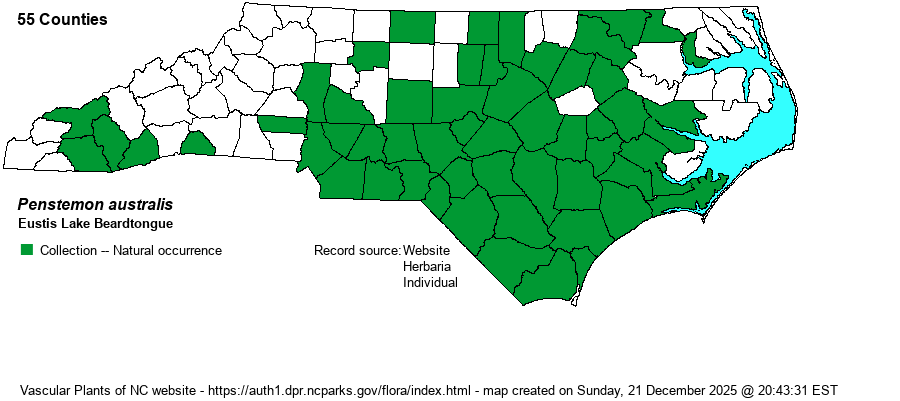| Author | Small | |
| Distribution | Throughout the southern two-thirds of the Coastal Plain and the adjacent southeastern Piedmont. Scattered in much of the northern Coastal Plain, but absent in the far northeastern counties. Also of spotty occurrence in the central Piedmont; a few collection records from several southern Mountain counties, where poorly known, though the species does occur in neighboring GA and TA regions.
This is a Southeastern species, ranging from northern VA and KY south to central FL and AL; however, it does range into low Mountain regions in TN, AL, GA, SC, and apparently NC. | |
| Abundance | Fairly common to common in the southern half of the Coastal plain, including the Sandhills region, where it is probably more numerous than elsewhere; uncommon in the northern parts, escept rare to absent in the northeast. Fairly common in the southeastern Piedmont, but rare to uncommon in the central and far northern portions. Very rare in the southern Mountains. | |
| Habitat | This is a species of dry to mesic, but sandy soil -- of pine flatwoods, more mesic portions of pine/scrub oak sandhills, sandy wooded borders, and various other partly sunny and rather dry sites. It is not a characteristic plant of the deeper sands of xeric pine sandhills. | |
| Phenology | Blooms from May to July, and fruits from July to August. | |
| Identification | This is a medium-sized herb, growing to about 2 feet tall, with some branching in the upper portions, but these are erect. Though it does have a few insignificant basal leaves, it is mainly the several pairs of opposite stem leaves that are to be examined. It has leaves about 2.5-3 inches long and about 3/4-inch wide, lanceolate, but with sessile and somewhat clasping bases; they are sparingly toothed. The inflorescence is a panicle but is fairly narrow, but can be 6 inches high. The widely scattered flowers are in small clusters that are on stalks several inches long, though each flower has a very short stalk. The rosy-pink flowers are strongly arranged horizontally, being tubular with little flaring of the tube (as some species have), and about 1-inch long but less than 1/4-inch wide. The species can be separated from the main other one growing within its range -- P. laevigatus -- by having a fairly hairy stem in the upper half, deeper rose color to the flowers with no red-purple lines on them, a more slender and non-flared flower, and narrower leaves. This species is not hard to find in the southern parts of the Coastal Plain, more so in the Sandhills. | |
| Taxonomic Comments | None
| |
| Other Common Name(s) | Southern Beardtongue, Sandhill Beardtongue | |
| State Rank | S4 | |
| Global Rank | G5 | |
| State Status | | |
| US Status | | |
| USACE-agcp | FACU link |
| USACE-emp | FACU link |

